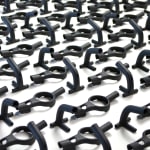
3D printing is unique as a disruptive technology in one key respect, and that is, having disrupted the manufacturing paradigm through the introduction of rapid prototyping some 25-30 years ago, it is now disrupting manufacturing again. This is based around the fact that today, 3D printing technologies have been refined to such an extent that they are truly viable production technologies. Now the conversation among manufacturers is around the most judicious use of 3D printing for production, what its advantages are, where the sweet spot is in terms of preferable volumes, what are the opportunities that exist through it use, and what are the barriers to entry?
Make or buy
There will be few manufacturing enterprises that will not either have used or are flirting with the adoption of 3D printing at some level in 2021, be it as a complimentary technology to existing legacy manufacturing processes, or indeed as an alternative. Many OEMs will be using desktop 3D printers for rapid prototyping, purely to get an early reasonably accurate 3D model of their product designs, but these printers are not designed for more exacting production applications, where repeatability and accuracy / tolerance attainment are vital.
The 3D printing machines that achieve production level repeatability and accuracy are typically costly beasts. Because of this, many potential users are put off by the large capital outlay required, and therefore approach 3D printing subcontract specialists, which not only have the levels of necessary high quality 3D printing machines in-house, but also have the experience to get the most out of them. The idea that 3D printing is a plug and play technology is a myth, and while entry-level desktop model printers only require a modicum of knowledge to operate, for production applications, to get the necessary build parameters, and to optimise quality, costs per part, and timeliness of build requires a heap of experience, which subcontract agencies have in spades.

Injection moulding - pros&cons
When it comes to the production of plastic parts, 3D printing is working in a space where the conventional processing technology is injection moulding.
Injection moulding is still the go-to technology for high volume plastic part production, but it is characterized by significant up-front capital investment in tooling, which is also time-consuming, and difficult and expensive to adapt. The technology can use several molds at the same time, which means that it is ideally suited to the mass manufacturer of parts and components cost effectively, its cost effectiveness also promoted by the fact that there is minimal wastage as material is precisely dosed to match specific mould requirements. In addition, while there is an increasing number of material options that can be used with 3D printing, it still cannot match the choice of materials that are compatible with injection moulding.
A significant drawback, however, is the fact that there are design limitations inherent in injection moulding, with some geometries being difficult to remove from the mold, and precise and delicate designs being difficult and expensive to mold accurately. Also, it is difficult, costly, and sometimes impossible to correct tooling mistakes or change tooling to optimise or iterate new designs. Often new tools are required, with all this implies in terms of cost and time, tools often taking weeks if not months to fabricate.
3D printing for plastic part production
3D printing exhibits a number of advantages when compared to legacy processes such as injection moulding.
The most important of these is the added flexibility 3D printing allows in design. Most obviously, 3D printing can make components either impossible or expensive and difficult to achieve using injection moulding, such as components that are hollow in certain areas. This is possible, as in 3D printing material is added in layers, and material density of the core can be altered. So, not only can some areas be hollow, but other critical areas can be reinforced. This means that 3D printing is a key facilitator when it comes to light-weighting but with increased strength. With 3D printing, ideal material conditions throughout a part are dictated by design not by the vagaries of various production and post-production processes used.


